

|
86.824 bytes |
Service Hints & Tips |
Document ID: MCGN-3MNQKH |
Vinca StandbyServer for OS/2 Warp - What is it?
Applicable to: World-Wide
What Is StandbyServer for OS/2 Warp:
Nowhere is high server availability more critical than in IBM OS/2 environments. Because of the robust feature set available in OS/2, many corporations run large, mission-critical applications such as IBM LAN Server Advanced, DB/2, and Lotus Notes on OS/2. Continuous access to data is vital.
Vinca's StandbyServer for OS/2 Warp connects a standby machine directly to a primary server via a dedicated communications channel called the Vinca link. StandbyServer software running on the standby machine exports disk devices in the standby to the primary server where they are treated as local disks of that primary server. Using standard mirroring software, data is duplicated to both the disks in the primary machine and the disks exported from the standby machine via the Vinca link.
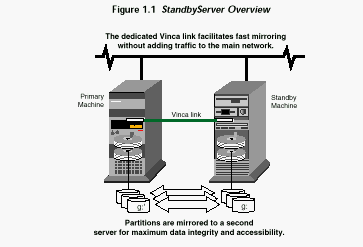
Because the mirrored data is located in a physically separate file server the data is protected against any failure of the primary machine. A RAID can provide data duplication protection, but failure of a disk controller or CPU means that data is unavailable until the RAID is moved to another machine. By putting the second disk devices in another active server, data is both protected and available in case of primary system failure.
What StandbyServer Does:
Vinca's StandbyServer provides complete server protection against hardware or software failure. As data is written to the primary server it is instantly mirrored to a second partition for data protection. If the primary fails for any reason, the mirrored data is as recent as the last disk write.
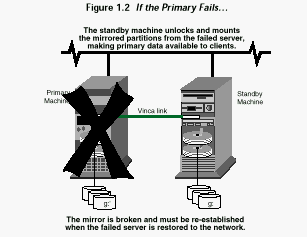
If the primary server fails for any reason becoming inaccessible to the standby machine via either the main network or the Vinca link the standby machine offers the failed server's data to clients as though it were the failed server. Clients can continue to access data after only a short pause as the failover happens.
StandbyServer uses existing mirroring software and mirrors data from the primary machine to the standby machine across the Vinca link. For IBM LAN Server Advanced file servers, StandbyServer works with LAN Server Advanced's built-in disk mirroring facility; for application servers that use OS/2 but not LAN Server Advanced, Vinca provides Cyranex Corporation's EZRAID Lite for mirroring.
IBM's NetFinity software can be used to automate switchover from the primary machine to the standby machine. NetFinity also allows a system administrator to customize alerts which can be sent to a local client, a remote console, or even a digital pager.
Disks, Partitions, and Mirroring:
In a StandbyServer installation the standby machine is a fully functioning file server that also acts as a backup for a single primary server. This allows a tremendous amount of flexibility in determining how resources are allocated and maximizes the use of expensive server hardware.
StandbyServer and Disk Devices:
StandbyServer lets you choose which disks are exported from the standby machine. The exported disks are locked from the standby machine, and are treated by the primary server as though they were local to that server. Exported disks cannot be accessed by the standby machine until the primary server fails and the standby fails over.
The standby machine must have at least two disk devices one that serves as the boot disk and stores local data and services, and one that is exported to the primary server to act as the second half of the mirror.
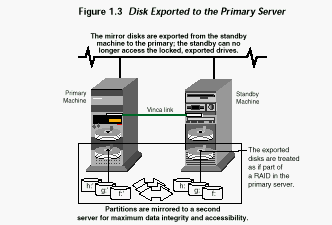
The local disk device(s) in the standby machine services local file server processes while the locked, exported disks serve as the second half of the mirrored pair established from the primary server. The mirrored data is as recent as the last disk write, providing full data protection.
When the standby machine stands in for the failed primary, the standby machine gives full access to the mirrored data. The standby machine now functions as the failed primary.
Important!
StandbyServer does require that the local disk devices on the standby machine be consecutive devices starting with device 0. At least one disk device must remain local to the standby machine to function as the boot device and to hold any local data.
The number and type of disks in the standby machine is limited only by the disk controller and operating system.
StandbyServer and Partitions:
The mirroring software mirrors partitions, not physical devices, so there is no need to have similar numbers of disks in the primary and standby machines. It is necessary, though, that each machine have the same number and types of partitions on the local disk device to ensure that drive letter designations remain consistent both during mirroring and after failover.
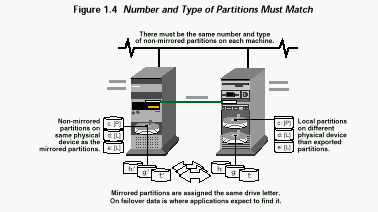
In this example (Figure 1.4) the boot device in each machine has three local partitions, one primary partition and two logical partitions. It doesn't matter that these partitions be on the same disk or that there be an equivalent number of disks in each machine. All that is important is that the number and type of non-mirrored partitions be the same in each machine so that the operating system assigns the same drive letter designation to both halves of the mirror. This ensures that data is still accessible after failover.
For example, the partitions shown in Figure 1.4 could be arranged as shown in the following example (Figure 1.5). What is important is that the operating system be able to assign the original partition and the mirrored partition the same drive letter, not that there be a similar number of disk devices or that each machine have similar partitions on corresponding disk devices.
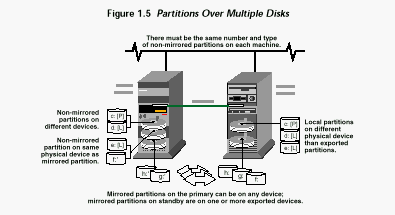
This may mean that you need to create partitions as place holders on either the primary or standby machine; these partitions can be very small or may contain no data. Again, what is important is that the number and type of non-mirrored partitions be the same, not that the partitions be a particular size or contain any particular data.
Notice in each example above that the primary partition of the mirrored set is actually located on the standby machine, not the primary machine. While this may seem counter-intuitive, it is necessary to ensure that on failover the standby machine recognizes the exported disks in the standby machine and can access them. The fault tolerance software running on the primary machine assigns the secondary partition in a mirrored set a partition type of 87 which is ignored by that machine's boot sequence. Because the fault tolerance software only runs on the primary machine, the secondary partitions on the primary machine are recognized as normal at startup.
StandbyServer and Mirroring:
Depending on the individual system configuration, different software is used to establish mirrored pairs. With LAN Server Advanced systems Vinca uses IBM's own mirroring software; for application servers that do not use LAN Server Advanced Vinca includes Cyranex Corporation's EZRAID Lite to establish mirrored pairs.
While each system uses different software to establish the mirror, there are a set of common considerations that must be observed for successful fault tolerance protection. This list reviews what has been discussed earlier in this section.
- The device containing the boot partition on the standby machine is not mirrored. Separate backup arrangements must be made to protect that data.
- There must be sufficient space on the primary machine to accommodate the exported disk(s) from the standby machine to mirror all desired partitions. For example, if the standby contains three 200 MB partitions, the primary machine must have at least 600 MB of space to accommodate the mirror.
- There must be the same number and type of non-mirrored partitions on each machine to ensure that partition lettering is consistent after failover.
- The primary partition in a mirrored pair resides on the standby machine, not the primary. This is taken care of by creating the partition on the standby machine.
- For the standby machine to access the data on the exported mirror disks after failover, the standby must be properly configured for, and have access to, the applications that use that data. Make sure that the standby machine can run the applications that are loaded on the primary, even if the application is not installed on the standby machine (but is installed on the mirrored disks).
|
Search Keywords |
| |
|
Hint Category |
OS/2 | |
|
Date Created |
08-10-97 | |
|
Last Updated |
22-09-98 | |
|
Revision Date |
21-09-99 | |
|
Brand |
IBM PC Server | |
|
Product Family |
Clustering | |
|
Machine Type |
Various | |
|
Model |
Various | |
|
TypeModel |
| |
|
Retain Tip (if applicable) |
| |
|
Reverse Doclinks |